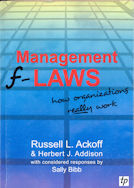This gem of a book introduces the extraordinary world of Systems Thinking and its “Dean”, Russell Ackoff,
to curious and enquiring managers, teachers, business people – anyone, anywhere who works in an organization.
Finished just before Professor Ackoff’s death late in 2009, it opens the door to a joined up way of thinking
about things that has profoundly influenced thinkers and doers in the fields of business, politics, economics,
ecology, biology and psychology.
In business and academia, in the public sector and in the search for solutions to the
environmental problems we face, both Systems Thinking and Russell Ackoff are being talked about more than ever.
This timely book presents 40 more of Russ Ackoff’s famously witty and incisive f-Laws (or flaws) of business –
following on from his 2007 collection Management f-Laws. All those in this collection are new and previously unpublished.
Andrew Carey’s extended introduction ties these f-Laws into the rest of Ackoff’s work and gives the reader
new to Systems Thinking a guide to the implications of Systems Thinking for organizations and managers.
This is a very slim (80 pages) book of two parts.
There is a 30 page introduction, by Andrew Carey,
giving an excellent summary of systems thinking applied to management.
This is followed by Ackoff’s “f-laws” #82–#123,
one to a page, each comprising a pithy title and a short description.
I felt the descriptions could have benefited from a bit more detail and explanation,
particularly the more counter-intuitive ones.
Maybe it would have helped to have read
Management f-Laws first, where the first 81 laws are laid out:
this was interesting enough to make me want to read that other, too.










